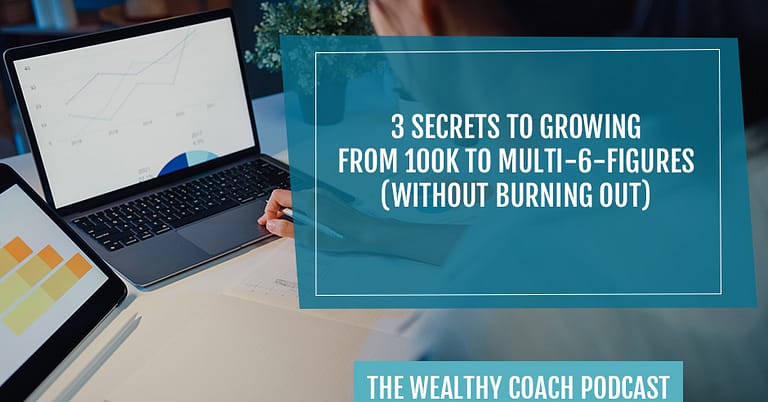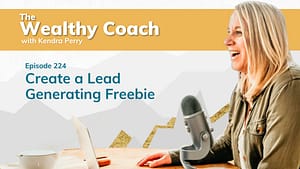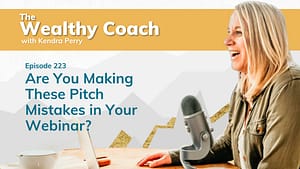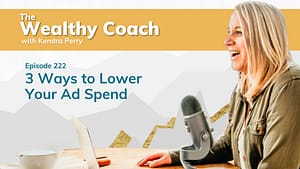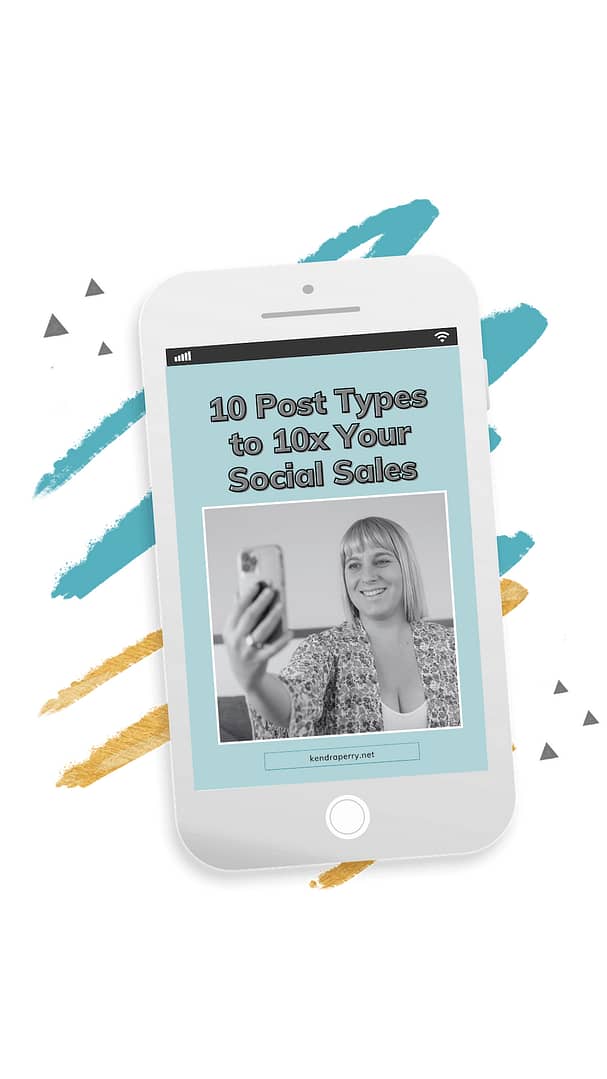Scaling your coaching business from 100K to multi-6-figures isn’t about working harder; it’s about working smarter and embracing the magic of number-based decision-making, building the right team, and offering high-value solutions. In this episode, Kendra Perry reveals the game-changing secrets you need to grow from earning 100K to achieving multi-6-figures, all without sacrificing your sanity. Today, she breaks down three essential strategies to catapult your business but also provide you with more freedom and control: number-based decision-making, building a team, and embracing high-ticket group programs. Don’t settle for less; aim for multi-6-figures with clarity, confidence, and control. Tune in now!
Give this podcast a 5-star review: https://ratethispodcast.com/wealthy
Do you qualify to work with us inside HCA? DM my the word ‘biz audit’ to Facebook: https://facebook.com/kendraperryinc or Instagram: https://instagram.com/kendraperryinc and I’ll take a look at your biz and determine if HCA can help you launch your first online program and fill it with dream clients.
—
Listen to the podcast here
3 Secrets To Growing From 100k To Multi-6-Figures (Without Burning Out)
As always, I love sitting down with you. This is going to be a fun episode. Before we dive into it, I have a little bit of housekeeping. Starting October 30th, 2023, I’m going to be doing a 5-day, 5-part show series. This is my first time doing this and I’m excited because I want to bring to you an incredibly valuable amount of content within a short amount of time.
This is going to be the Master Your Marketing Series so that you can enroll more clients and make more money. We’re going to be covering a different topic Monday through Friday. If you want to tune in to that, you don’t have to do anything. All I recommend that you do is make sure you’re subscribed to the show so that you don’t miss those episodes when they come out starting on the 30th. It’s going to be super fun and super valuable, so stay tuned for that. Again, nothing to do, just make sure you’re subscribed to the show and enjoy the free content.
In this episode, I want to dive into a little bit more of an advanced topic. This has been requested because I know we have more advanced people following me on the show lately. People who are at maybe $80,000, maybe $90,000, even $100,000. They’re looking to grow to multiple 6 figures plus, even the high end of multiple 6 figures, even 7 figures. They’re wondering how to do this. Typically, this is usually around the $80,000 to $100,000 mark. It’s a number that people often get stuck at. The big reason for this is that what gets you to $100,000 isn’t what gets you to high multiple six figures.
This was a lesson that I had to learn and I had no idea because a lot of people don’t talk about this. A lot of things that we learn about are more geared towards getting to 6 figures, which is great, but things shift if you want to get to high multiple 6 figures and even 7 figures. It’s going to be talking about three different secrets that I’ve learned to make this kind of growth. By implementing these in my own business, I was able to go from $250,000 a year to $750,000 a year. Tripling my income, which is huge.
Number-Based Decision-Making
Some of these might surprise you because it’s not making more content. It’s not necessarily running Facebook Ads, though that can help. Anyway, I’m going to stop building all this anticipation. Let’s get into it. The first one is big, and this is going to be challenging for a lot of coaches. It was challenging for me. Honestly, it’s still challenging for me. I still have to always remind myself to do this. That is number-based decision-making.
A lot of times we make decisions off on feelings and emotions and we’re not making decisions off on numbers. A lot of coaches will put off tracking their numbers. They don’t like numbers or they have this story that they’re bad at math. I hear this one all the time, “I’m not good with numbers. I’m not good with math.” Honestly, if that is a story you’re telling yourself, I’m going to challenge you to change that story.
If you tell yourself you’re bad at math and you’re bad at numbers, then you are going to be. You can flip the script on that by changing the story you’re telling yourself. The good news is you don’t have to do a lot of math. You can get something like ChatGPT or Google to do the equations for you. You do want to get into the habit of tracking your numbers monthly, looking at them, and making decisions based off of them.
An example from one of my Health Coach Accelerator students. She told me, “I want to make this new freebie. I want to put together this whole webinar because the other one I have isn’t working. It’s not growing my email list.” I was like, “Hold up because making a webinar is a huge undertaking. This is going to take you a month to make and it may not even work because there’s so much that goes into it. I want to know why isn’t this growing your email list. What are your numbers? What’s your opt-in?” She didn’t have an answer because she had no idea. I was like, “We can’t make decisions without any data because you could make this whole new free offer when the one you have is working. We just maybe need more traffic or maybe we need to tweak the landing page copy.”
Upon providing me her numbers, I can’t remember the exact numbers, so I’m going to make something up, but it was low. It was maybe 82. 82 people had landed on her opt-in page and maybe 10 people had opted in. That essentially is an 8.4% conversion. 8.4% of people who are landing on that page are opting into her freebie. That’s low because we want to get at least 30%, which is our minimum goal. When you’re promoting to warm traffic for people who already follow you on social media, who know, like, and trust you, ideally, we want that to be higher, but we are aiming for at least 30%.
That’s low. Based on that, you could say, “Maybe we need to make some decisions about the copy on the opt-in page. We need to tweak some words. We need to tweak some headings.” Truthfully, 84 is a low number. Typically, I want at least 200 views on an opt-in page before I make any decision. At this point, we don’t know if the freebie’s not converting. The problem is that she doesn’t have enough traffic. Think of the decision we’re going to make based on that. Her initially thinking, “This freebie isn’t working,” we don’t know that enough because we don’t have enough traffic to test it.
The goal is to get more traffic to the page by promoting it more, by maybe putting some ads behind it, and that sort of thing so that we can test it and see if it’s working, versus spending 1 month or 2 creating an entire webinar that may have the same outcome because the traffic isn’t there. We want to make a number-based decision. We want to move away from emotions, guessing, and feelings, and try to be logical.
There is a place for intuitiveness, emotion, and feelings in your business, but when it comes to decision-making about where to put more of your efforts, where to put more of your time, and where to put more of your budget, we need to make it based on the number. You want to track your numbers monthly. You can create an Excel spreadsheet for it. This is something I give my HCA students.

I’m going to give you an idea of what numbers to track because maybe you’re like, “What numbers should I be tracking?” The first one you want to be tracking is important. This is the profit margin. This is the percentage of profit that you take home after expenses. Essentially, you take your net profit. This is your profit after expenses. Take your gross revenue, everything that you make minus expenses. That’s the number that you want. You want to divide that by revenue, get that number, and then times it by 100. That will be your profit margin.
For example, if you have a revenue of $100,000, that’s all the money you make. You then have expenses of $80,000. That means your net profit is going to be $20,000. What you would do is take that $20,000, divide it by 1,000, times it by 100, and get 20%. You’d have a 20% profit margin. You could ask ChatGPT to do this calculation for you or you can get it on Google if you’re not following.
Now, because we’re an online business and we don’t have inventory, I recommend that you aim for at least a 60% profit margin, if not higher. This is important because this helps you stay on track with your expenses. Maybe you are making $100,000 a year and you have $20,000 a year in expenses and $80,000 profit, that means you have an 80% profit margin. That would be fantastic. This is important because we want to make sure that we are not overinvesting in our business. You’re going to want to track sales call conversion. This means what percentage of people who buy is based on the number of people who book calls.
We’ll keep it simple. Let’s say ten people book sales calls. You have three people buy. That’s a 30% sales conversion. Now, 30% is industry standard. A lot of my students will convert much higher because I provide them with a magic sales script. It’s amazing, but 30% is standard. That’s good to know because maybe you’re booking 10 calls, you’re getting 3 sales, and you think something’s wrong with you. You think you should be booking more, but you are right on track.
The other thing you’re going to want to track if you’re doing sales calls is no-shows because it’s normal to have no-shows. Typically, about 25% of people won’t show up. You want to get to know these numbers and get to know your averages because this will help you determine how many calls you need to book every month. For example, let’s say you have booked twenty sales calls. You know that.
Let’s say that you have a 50% sales call close rate. I’m using easy numbers. You’re like, “I have a 50% sales call close rate and about 25% of people don’t show up. That means if I book 20 calls this month, about 15 of them will show up, and I will make 7.5 sales. I am selling my program for $2,000. That’s going to be $15,000.” Let’s say your goal is to make $15,000, then you know, “I have to book 20 sales calls every month to average those 7.5 sales and make my $15,000.”
Do you see how this works? Instead of shooting in the dark and being like, “I got this many calls this month,” we can strategically try to book twenty calls each month. That means if you are 50% through the month, it’s the 15th of the month and you only have 5 sales calls on the books, then you are going to hustle for more sales calls. Maybe that is running more ads or increasing your budget. Maybe that’s sending out a few more emails to your email list or making more social media posts.
If you are selling in a different way, maybe you’re selling through a live launch or live webinar. Maybe you are doing a webinar every couple of months or every month, whatever it is. There are a lot of different ones you’re going to want to track, but a really important one when it comes to launching or even an evergreen funnel, like an automated webinar, is something called lead-to-sale conversion. This is the number of sales you make based on the number of people in the event. The event could be the webinar. It could be the automated webinar. It could be a free challenge. It could be a workshop series or whatever it is.
It’s important because this is how you can plan for your launches. A lead-to-sale conversion in a live event, it’s typical to have about 3% to 5%. That can be a lot higher. I’ve had lead-to-sales conversions as high as 10% to 15%. Again, if you’re doing 3% to 5%, you’re doing well, but you can get higher, and we always want to compare our numbers with our numbers. For example, for my live webinar, I will typically close at about 5% to 10% for lead-to-sale conversion. That means if I have 100 people register for my live webinar, about 5 to 10 people will purchase. I get typically a 5% to 10% lead-to-sale conversion. Let’s average it and put that at 7.5%.
Maybe you’ve done your webinar once and you get 7.5%, that’s maybe not going to happen every time, but after you do that webinar, maybe 4 or 5 times, you can start to come up with an average. Let’s say my average is 7.5%. I know that I will typically close 7% to 5% of people who register for my webinar. That means I’m like, “I want to have a six-figure launch. I want to make $100,000 in my launch. How many sales do I need to make?” Essentially, I could figure this out.
Let’s pretend that my program is $2,000 and I want to make $100,000. I have to first figure out the number of sales I would need to make. We would divide $100,000 by $2,000. That would be 50 sales. All I need to do is I need to take 50 and I need to divide it by 0.075 or the decimal version of 7.5%. That number is 666. What that means is I need to get 666 people registered for my webinar. If I close at that average 7.5%, then I would make $100,000.
Hopefully, what you can see is that launching is a numbers game. In order for it to be as simple as a numbers game, we have to figure out what our average is. This means that we typically would need to run a live webinar several times and figure out what we’re generally converting on. That’s how we can figure this out. There are other variables that go into this. You could have tech issues, you could maybe not be on your game, or it could be a funny time of year. Maybe you’re going to get a lower conversion and you don’t always hit your goal. That’s fine. Sometimes I believe that we make goals not always to hit them. We just make those goals to teach our minds what is possible. That is an important number to know.

We talked about this a little bit at the beginning of the episode. It’s an opt-in page conversion. If you have a freebie and you want to know if it’s working for you, you want to know the opt-in page conversion and the number of people who are landing on that page. Let’s say you’re like, “My email list isn’t growing the way that I wanted to.” Do you need another freebie? Maybe not.
For example, let’s say we look and see that 1,000 people have landed on my opt-in page, but only 100 people have opted in. That would be a 10% conversion. We want to get that at least 30%. That’s pretty low. That could mean a few different things. You might need to change the copy on your landing page. It’s pretty low, so it might mean that you need to change that freebie and try something else.
Let’s say your opt-in page conversion was 21%. It’s not 30, but it’s not too far off. That probably doesn’t mean we need to change the entire freebie. It probably means we need to make some tweaks to the landing page and probably just small changes, because it’s pretty close to 30. Maybe we would need to change the headline or change the image, and then change one thing, wait a little while, see what happens. These are some of the numbers that you’re going to want to track, profit margin, sales conversion, and lead-to-sale conversion if you’re launching or doing anything automated. They’re important. We want to make decisions based on this.
This is extra important if you’re doing anything evergreen. For example, with my evergreen webinar funnel, before I was able to optimize it and start getting sales from it, I had to break down the entire funnel. I launched the thing. I wasn’t getting sales. The first thing I did was look at the top of the funnel, which is the registration page. What I noticed was that registration was low at 20%. I changed a bunch of the copy, and then eventually changed an image, and then was able to get that opt-in up to 35%. I was like, “Great. Fix that part of the funnel.” Still not making a sale. What’s the next part of the funnel? Where do they go next? They go to watch the webinar.
The first thing I wanted to look at is what percentage of people who sign up for the webinar are watching the webinar. How many people go through and watch it? This is why you have evergreen webinar software because it’ll give you these analytics, which is very cool. What I learned was that 30% of people were watching, so that was good. I didn’t need to change that. What happens next? I got to look at how much of the webinar are they watching. If they’re not getting to the pitch, then I’m not going to make the sale. What I learned was that most people were dropping off at 40 minutes, but I didn’t start pitching until 60. That’s a problem. What that told me was that I needed to shorten my webinar.
Hopefully, you can see how strategic this is. Instead of me being, “This isn’t working. Stupid evergreen funnel. Screw this thing. I’m going to start all over.” I strategically had to work through everything, which honestly can be hard because we have emotions and feelings. We’re emotional beings and we want to change everything. A lot of times, it’s about making these micro changes and letting yourself follow the data. Number-based decision-making is number one, and it’s important.

Building A Team
Number two is the team. A lot of us can get to six figures with minimal team members, if any. I was doing pretty much six figures, and I don’t think I had a virtual assistant. Once I started growing, I very quickly had to hire someone. A lot of times, we’ll think, “I need one virtual assistant and we’ll stop there.” That’s a problem.
Growing a team is important. I don’t believe you need to have a big team, and I’m not someone who has a big team or wants employees or anything like that. I have a bunch of little contractors doing work for me. However, you have to learn how to not only outsource, but you have to learn how to delegate. Important because you cannot do everything yourself. If you want to get to the high multi-six figures without burning out, then you have to find the right team member.
I joined a mastermind a few years ago. I wanted to grow from the 300,000 mark. I’d been stuck at that for a few years. When I joined this mastermind program, I thought I was going to get strategy or at least that’s the reason why I joined. I was like, “I need better strategy.” What I learned is that I needed to learn leadership, how to delegate, and run a team. I remember I did this time audit for my coach. He went through it and he’s like, “There are no major red flags, but I noticed that you’re doing a lot of delegation, but you have an online business manager. What does your online business manager do?” I was confused. What I realized is that I’d been micromanaging my online business manager and I wasn’t using her to her full potential.
An online business manager is meant to manage your business and manage contractors. When I have something like a launch, she is meant to plan all the things, and then delegate the tasks to me that I need to do. It’s almost like you’re working for your online business manager except you’re still the boss. I learned I was micromanaging which is horrifying to me because I hate micromanaging. I remember being micromanaged, wanting to die, and feeling like my soul was dying. I had to give over full trust to my OBM, my Online Business Manager, and allow her to do her job, and I had to start delegating.
Something that I’ve always struggled with is this feeling of not wanting to annoy people. I don’t want to tell people to do something because I don’t want to be annoying and I don’t want to be bossy, but that’s why you hire a team. I had to learn how to properly delegate. Something I learned from my coach, which has been incredibly valuable is that when I delegate something, I tell people why it’s important and how it fits into the overall picture. What I was doing before is I was telling people, “Do this task.” When people don’t understand why they’re doing something or how it fits into the overall mission, they don’t care as much and they don’t take as much ownership for the task or the project.

Something we do is every time we delegate something, we write a little thing on why it’s important and how it fits into the overall thing. As an example, if I’m writing a little instruction manual for customer service, I would say, “This is important because we value customer service. We want our students and prospects to feel incredibly supported. We want them to feel like they are seen, heard, and understood. This is important because it keeps the company alive and it helps us make sales.” That means the customer service person now understands why their role is critical.
The other thing we add to the write-up is what done looks like. Ultimately, we all have different perceptions of what done looks like. Maybe I think done looks like this, and then the other person is under the perception that done looks like this, and it’s not aligned. That’s a big reason why we are unhappy with people who work for us because they are not performing or doing the job the way that we think it should. We don’t want there to be any question. We put a paragraph on what done looks like so that there are no questions and the person can’t say, “I thought I was doing it right,” because we tell them exactly what the outcome should look like.
As an example, with customer service, we’d say something like what done looks like. It’s done when the inbox has been cleaned up, emails have been filed into the correct folders, every response has been responded to within 24 hours, and every inquiry has been tied up within 24 hours if possible, essentially. Again, there are no questions.
An important thing to do and this will save you a lot of time in your business and with hiring, is to create a company manual. We’ve built our company manual out into Asana, which is a project management tool, but there’s also Trello, Monday, or Notion. There are lots of different ones you can use, or you could just use a simple Google Doc if you like to keep things simple.
Essentially, all the step-by-step processes are documented. We start with the name of the task, why it’s important, and what done looks like, and then we have the step-by-step instructions either written out or with a Loom video, which is a screen share recording software where you can create a link. Someone will walk you through how to do something. We also have the amount of time on average that it takes. This is important because then when we bring in new team members, they can refer to the company manual and they know exactly how to do it. They don’t need to ask me every time. Also, they know how much time we expect it to take them. If a task takes about 15 minutes, they’re not going to be billing us 45 minutes because we said, “You can do this in about 15 minutes.”
The team is important because it takes things off your plate. A lot of big reasons why entrepreneurs burn out is because they try to do everything themselves. Truthfully, if I didn’t have any team members, I would probably be working 60 hours a week, maybe even more because there’s so much to do in my business at this point. I have no desire to work 60 hours a week. I’m a lifestyle entrepreneur. I work about 25 hours a week. Honestly, that works for me. I like that.
The only reason I’m able to do that is with a team. That’s the way that I spend my time because now I’m not working on admin stuff. I’m not answering customer service emails, and I’m not managing people. I have an online business manager who does that. My time is spent on promotions and sales. That’s updating programs. I update programs, I work on promotions, I sell, and I make content. That’s all I do. The only things I’m working on are things that move my business forward.
High Ticket Group Program or Course
Now, the final one is one high-ticket group program or course. High ticket is subjective, but I would say that you’re selling something that’s at least $1,500 or more. It can be a group program or course, but it is a one-to-many business model. You can get to six figures with one-on-one. Honestly, that’s the easiest way to go for most people, is to get the six figures with one-on-one. You can probably even go beyond six figures with one-on-one. I know my old student, Angela Brown, was doing $250,000 with mostly one-on-one. You can get to multiple six figures, but ultimately, you’ll create more time and freedom with a one-to-many program.
That can be a group program or a course or it can be something like I teach inside Health Coach Accelerator, which is this beautiful intersection between a group program and a course, which is effective for the health and wellness industry. The reason why I say one is because multiple offers tend to be less profitable. Why is that? It’s because a lot of us when we’re not making the money we want, we want to put out more offers. The problem is our time gets split because we think every offer is a separate business model. Each offer needs a different avatar, a different funnel, and a different sales strategy. Honestly, it’s a lot of work.
I say this from experience because I have two programs. I wish I just had one program, but honestly, I couldn’t imagine not having HCA and not having an HTMA Expert. They serve different purposes to me. Honestly, I think that if I focused on one of them, I would probably be at seven figures, to be honest. The reason is because my time is split. I can never give each program my full attention. They both get a lot of attention, but neither one gets my 100% attention all the time. I go through phases where I focus all in one. If I just had one, I’d probably be doing a lot better in my business. Call me a stupid business owner, but I have two.
The goal is to try to get down to one high-ticket group program because that allows you to work less. Also, this allows you to focus on making one amazing program because truthfully, your program takes time to optimize and it takes time to make better. As you learn, you gain more knowledge and experience and see what works and what doesn’t work for your students. Sometimes when we’re stuck maybe at $100,000 or $80,000, we want to add on another program, but it might be about optimizing the program that we have.
I do recommend focusing on that one high-ticket group program or course, and that’s at least $1,500. Can you sell a cheap course for $97? Yes, but you’re going to need a much higher volume of traffic. It’s a much harder business model because you need to make more sales. You have massive Instagram followers. If you have 100,000 followers on TikTok, Instagram, or whatever, that business model might work for you, but as it is increasingly hard to grow a big following, I do recommend that high ticket.
You can sell a course for $1,500 or more and you can sell a group program for $1,500 or more. If you want to make that very hard jump from $100,000 to high multi-six figures and beyond, these are the three things you need to embrace. That’s number-based decision-making, building a team to support you, not a big team but a team, and then your one high-ticket group program or course.
I hope you enjoyed this episode. It’s been super fun to hang out with you. Make sure you are subscribed to this show so that you don’t miss my five-day show series on Mastering Your Marketing starting on October 30th, 2023. If you love this show and you want to support me a little bit further, you can give this show a five-star review. Just go to RateThisPodcast.com/Wealthy. I will see you in the next episode, same time, same place where I help you become wealthy AF.
Important Links
- Health Coach Accelerator
- HTMA Expert
- Asana
- Trello
- Monday
- Notion
- https://RateThisPodcast.com/wealthy
- https://Facebook.com/kendraperryinc
- https://Instagram.com/kendraperryinc

